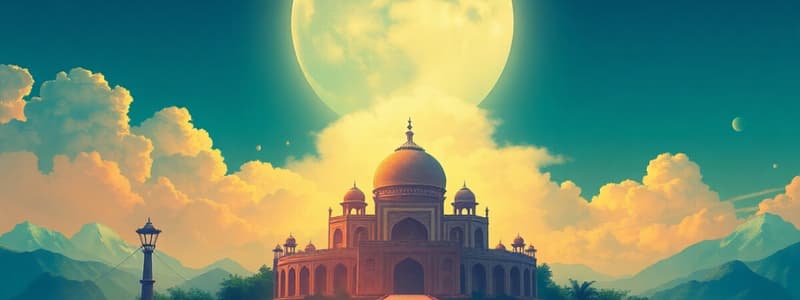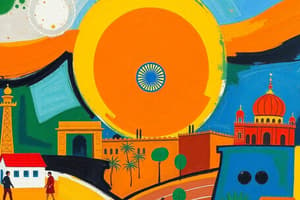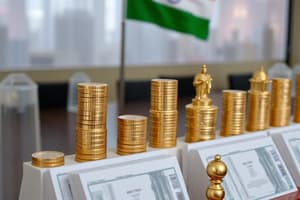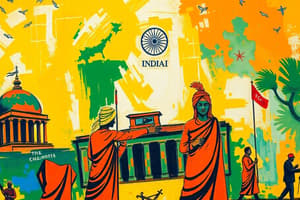Podcast
Questions and Answers
Some economists argue that farmers in other countries, particularly ______ countries, are subsidized.
Some economists argue that farmers in other countries, particularly ______ countries, are subsidized.
developed
The major ______ initiatives in the agriculture sector were land reforms and the green revolution.
The major ______ initiatives in the agriculture sector were land reforms and the green revolution.
policy
The ______ plans addressed the question of how to distribute goods and services among people.
The ______ plans addressed the question of how to distribute goods and services among people.
Five Year
After independence, India envisaged an economic system that combines the best features of socialism and capitalism, known as the ______ economy model.
After independence, India envisaged an economic system that combines the best features of socialism and capitalism, known as the ______ economy model.
The proportion of people depending on agriculture did not ______ as expected.
The proportion of people depending on agriculture did not ______ as expected.
A key focus of the five-year plans was to understand how to produce ______ and services in the country.
A key focus of the five-year plans was to understand how to produce ______ and services in the country.
One of the major drawbacks in the industrial sector was the inefficient functioning of the ______ sector.
One of the major drawbacks in the industrial sector was the inefficient functioning of the ______ sector.
The five-year plans sought to determine the most efficient way to produce goods and services, considering the use of ______ and machines.
The five-year plans sought to determine the most efficient way to produce goods and services, considering the use of ______ and machines.
Students undertaking a case study of an agricultural farm would investigate the ______ of farming methods.
Students undertaking a case study of an agricultural farm would investigate the ______ of farming methods.
______ substitution policy initiatives in the industrial sector raised its contribution to GDP.
______ substitution policy initiatives in the industrial sector raised its contribution to GDP.
The major policy initiatives in the agriculture sector were land reforms and the ______ revolution.
The major policy initiatives in the agriculture sector were land reforms and the ______ revolution.
Comparing data from different agricultural farms could reveal variations in ______, productivity, and income.
Comparing data from different agricultural farms could reveal variations in ______, productivity, and income.
The common goals of five-year plans are growth, modernization, self-sufficiency, and ______.
The common goals of five-year plans are growth, modernization, self-sufficiency, and ______.
Newspaper articles about the ______, IMF, and WTO provide insights into the global economic landscape.
Newspaper articles about the ______, IMF, and WTO provide insights into the global economic landscape.
Analyzing the occupational structure of the Indian economy reveals changes in the ______ of different sectors.
Analyzing the occupational structure of the Indian economy reveals changes in the ______ of different sectors.
Understanding the arguments for and against agricultural ______ is essential for formulating sound agricultural policy.
Understanding the arguments for and against agricultural ______ is essential for formulating sound agricultural policy.
Flashcards
Mixed Economy
Mixed Economy
An economic system combining socialism and capitalism.
Five Year Plans
Five Year Plans
Economic planning framework developed for India focusing on growth and self-sufficiency.
Green Revolution
Green Revolution
A period of agricultural transformation through high-yielding varieties and improved techniques.
Import Substitution
Import Substitution
Signup and view all the flashcards
Land Reforms
Land Reforms
Signup and view all the flashcards
Marketable Surplus
Marketable Surplus
Signup and view all the flashcards
Self-Reliance
Self-Reliance
Signup and view all the flashcards
Growth with Equity
Growth with Equity
Signup and view all the flashcards
Regulated Economy
Regulated Economy
Signup and view all the flashcards
Production Decisions
Production Decisions
Signup and view all the flashcards
Agricultural Subsidies
Agricultural Subsidies
Signup and view all the flashcards
Occupational Structure
Occupational Structure
Signup and view all the flashcards
Development Policies
Development Policies
Signup and view all the flashcards
G7, G8, G10 Meetings
G7, G8, G10 Meetings
Signup and view all the flashcards
Study Notes
Indian Economy 1950-1990
- Learners will understand India's five-year plans
- Learn about development policies in sectors like agriculture and industry from 1950-1990
- Understand merits and limitations of a regulated economy
Introduction
- India gained freedom on August 15, 1947
- Leaders aimed for an economic system promoting national welfare rather than favoring a select few
- Nehru favored socialism, differing from the Soviet Union's model
- Nehru, and others, sought an alternative to extreme capitalism and socialism
- They valued the aspects of both and wanted a balanced system combining the two
Economic Systems
- A market economy (capitalism) relies on supply and demand for production and distribution
- A socialist economy is centrally planned, with the government defining production and distribution based on societal needs.
- A mixed economy combines elements of both market and centrally planned economic systems, allowing certain levels of private ownership while also utilizing regulation from the government to guide economic actions.
What is a Plan?
- A plan outlines resource use, general and specific goals
- Goals may conflict; planners balance them
- India's five-year plans do not specify precise output levels for all goods and services
- Plans focus on certain sectors (e.g., power, irrigation) while leaving others to the market
The Service Sector
- As countries develop, the agricultural sector typically shrinks, and the service sector expands
- In India, the service sector's growth in the 1990s was rapid
- The 1990s saw a significant increase in the GDP share of the service sector
Mahalanobis
- A key figure in Indian planning was Prasanta Chandra Mahalanobis
- He was a notable statistician
- His contributions were central to India's second five-year plan, which was a landmark in development planning
- He believed in a balanced approach to economic development, combining aspects of socialism and some elements of market principles
Land Reforms
- Land reforms aimed to distribute land more equitably
- Policy of “land to the tiller”
- Land ceilings limited land ownership
Green Revolution
- Increased food grain production using high-yielding seeds (HYVs)
- Involved using more fertilizer, pesticides, and irrigation
- Benefited larger, wealthier farmers more than smaller farmers
- Led to potential economic and social disparities
The Debate Over Subsidies
- Subsidies to farmers were necessary to support the adoption of new technologies
- Subsidies aimed to help, and could also cause economic disparities
- Experts argued about whether to eliminate them or not
Trade Policy: Import Substitution
- This policy aimed to replace imported goods with domestically produced ones
- Goal was to protect domestic industries and promote economic self-sufficiency
- Involved tariffs and quotas to reduce imports
Effect of Policies on Industrial Development
- India's industrial sector saw significant growth from 1950 to 1990
- The sector experienced diversification
The Public Sector
- The public sector played a key role in the growth of the Indian economy (infrastructure, services, etc)
- Controversies surrounded the public sector's effectiveness and efficiency
Studying That Suits You
Use AI to generate personalized quizzes and flashcards to suit your learning preferences.




